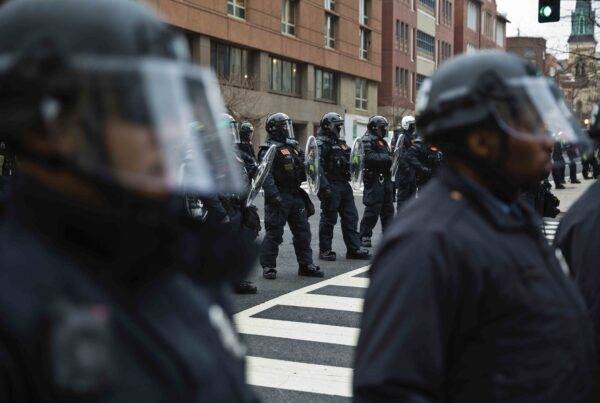by George L. O’Brien
edited by Geoffrey Erikson
The tax-supported “public school” system is in trouble. There are chronic problems with discipline, mounting violence, declining test scores, and administrative costs spiraling out of control. Government schools continue to graduate functional illiterates, and US public school students’ math skills are now among the worst in the industrialized world.
How bad is it? The US has 27 million illiterates as well as 40 to 50 million people who can barely read at the fourth-grade level. The US is also among the worst industrialized countries in the areas of math and science. More than half of all 18-year-olds cannot find Britain or France on a map.
The defenders of the government schools claim the problem is a lack of money. However, in real terms, spending on education has actually risen over the last 40 years. The US ranks near the top in the world in per student spending – more than either the Germans or the Japanese. The cost per student in government schools is nearly twice that of a typical private school, yet the results are distinctly inferior.
There is so much dissatisfaction with government schools that many parents are paying to send their children to private schools. This is after having already paid for government schools through their taxes. It is a ringing testimony to the failure of one of this country’s most ambitious social experiments.
The public schools movement began in the 1830’s, led by Horace Mann. Supposedly, the goal was to ensure that every child would have access to an education. However, from the beginning there was another agenda, and that was to control what was being taught so as to create so-called model citizens. Public schools meant taking control of education from the parents and placing it in the hands of social engineers and the government.
Was there ever a popular outcry for government schools? The answer is no. Basically, the demand for government schools came from élites in response to two perceived threats to their notion of society: 1) the rise of thecommon peoplewho were becoming politically active; and 2) the influx of immigrants.
These political and intellectual élites promoted what was then considered an un-American value system in the government schools: Blind obedience to authority; conformity; equating patriotism to loyalty to government; externally imposing ranking of people in a military-like hierarchy; and perpetuating the myth that knowledge is a scarce commodity to be obtained only from an élite educational priesthood.
Many parents resisted these attempts by government bureaucrats to impose alien values on their children. Most ethnic groups also came to resent the way the élites tried to undermine and usurp their parental authority – the most obvious example being the Catholics who felt the need for their own schools.
Fortunately, the full impact of the government schooling system was mitigated by the decentralism of the 19th Century. Virtually every school had its own autonomous school board. These local school boards had the power to hire and fire teachers at will – based on their own judgments.
However, after the turn of the century, during the Progressive Era, there began a concerted attempt to destroy the system of local control through the unified schools movement. It took 50 years before most of the country was subjected to unified schools, which may be why the real decline was delayed until after World War II. The idea behind unified schools was that they would be able to offer a wider variety of courses because of economies of scale. However, the real goal seems to have been to remove control of the schools from the parents and place it in the hands of the professionalsin the school bureaucracies.
At the same time, there began the movement to require teachers to attend specialized teachers’ collegesand the dictating of mandatory state certification. The criteria for hiring was now graduation certificates from teachers’ colleges, rather than demonstrated skill in teaching. In many states, local school boards were actually forbidden from conducting their own testing of teachers.
Once the parents lost control of the schools, the schools quickly became laboratories for social engineering experiments. Educational fads such as progressive education were imposed on the helpless children in vain attempts to use behaviorist psychology to remodel children into some vision of “proper” citizens. Everything from sex education, to politically-correct textbooks, to forced bussing, all became methods of molding children into some ideal image. The legacy of Horace Mann would be the tyranny of government control and bureaucratic manipulation.
Centralization took another giant step in the 1950’s as funding of schools began to be moved to the state governments. The primary result of this was an explosive growth in the size and power of the school bureaucracies. According to Steve Buckstein of the Cascade Policy Institute, the Portland, Oregon schools district has 600 employees in its central office, or roughly one central office employee for every 92 students. By comparison, the Portland-area Catholic school system with 11,500 students has only five central office employees, for a ratio of about one central office employee for every 2,300 students. The government-run schools have 25 times as many people in their central office.
Ending the linkage between parents and the schools also removed all barriers to the takeover of the schools by the teachers’ unions: the National Education Association and the American Federation of Teachers. These unions have made it virtually impossible to fire incompetent teachers. They have forbidden wage differentials for outstanding teachers or higher pay to attract teachers in subjects where there is a scarcity, such as math and science. In addition, since the administrators are also members of the unions, it has became virtually impossible to reduce the size of the bureaucracy. The state school bureaucracies have transformed areas such as curriculum into a political battlefield. State textbook selection has led to fierce struggles between various special-interest groups. Choosing history and social science texts is an area of constant conflict. In the area of biology, small groups of evangelical Christians have forced the “dumbing down” of science textbooks, while the denizens of political correctness have made history and social science texts nearly worthless.
Government control of schools has had a disastrous effect on racial minorities such as blacks. Brown v. Board of Education outlawed segregation in public schools, however, in place of parental control a new set of controls and forced bussing was substituted, which without question failed. It ignored the unique problems of each child and was detrimental to the education of all. Not surprisingly, in recent years it has been racial minorities who have led the fight to overturn these rulings. In cities such as Chicago, it has caused many African-American parents to put their children into private and Catholic schools.
Another failed social experiment had to do with IQ tests and special “tracking.” As John Taylor Gatto (New York State Teacher of the Year in 1991)put it: David learns to read at age four; Rachel, at age nine: In normal development, when both are age 13, you can’t tell which one learned first – the five-year spread means nothing at all. But in school I will label Rachel ‘learning disabled’ and slow David down a bit too. I adjust David to depend on me to tell him when to go and stop. He won’t outgrow that dependency. I identify Rachel as discount merchandise, “special education.” After a few months she’ll be locked into her place.
Stereotyping of students using standardized tests can create enormous problems when dealing with racial minorities.
Other experiments have included using psycho-active drugs to counter “hyperactivity in children” without the permission or even the knowledge of the parents. What is especially ironic is that studies now indicate that many hyperactive children are likely to grow up to be successful entrepreneurs.
A related problem includes the inability to expel disruptive or undisciplined students, because the state pays for warm bodies rather than educational results. It is not a coincidence that crime is a big problem in many inner-city government schools, but not a problem in the non-government schools.
Educationists and their unions have resisted parents’ desires for choice with everything they can muster. Tactics include using the state to decide what constitutes a school, imposing expensive rules and regulations on non-government schools, and using truancy laws to harass home-schoolers.
The central struggle, of course, is money. As long as the government schools take so much money from parents in taxes, it is hard for parents to afford to send their children to non-government schools. Attempts to change this through tax credits and vouchers have resulted in vicious counter-attacks from the NEA among others. As Gatto put it: School has become too vital a jobs project, contract giver, and protector of the social order to allow itself to be “reformed.” It has political allies to protect its marches.
Education choice involves returning control of education to the parents rather than the bureaucracies. History has shown that the system of centralizing control has resulted in poor results and a massive waste of resources.
The battle cry for choice in education is central to bringing about a free society. Government schools are not simply another “black hole” for tax dollars, but an institution which does actual harm to our children.
The only way the US will get quality education will be when control is returned to the parents who can have a real choice, versus the sterile monopoly of the government schools. Creative projects such as the Arizona School Trust, a private foundation which provides scholarships for low-income students, will chip away at the basic legitimacy of government schools.
George L. O’Brien is a prolific libertarian writer, policy analyst, lecturer and political strategist.
This pamphlet was originally published in 1993 and revised in December 1997. It is part of ISIL‘s educational pamphlet series. Click here for the full index of pamphlets online.




